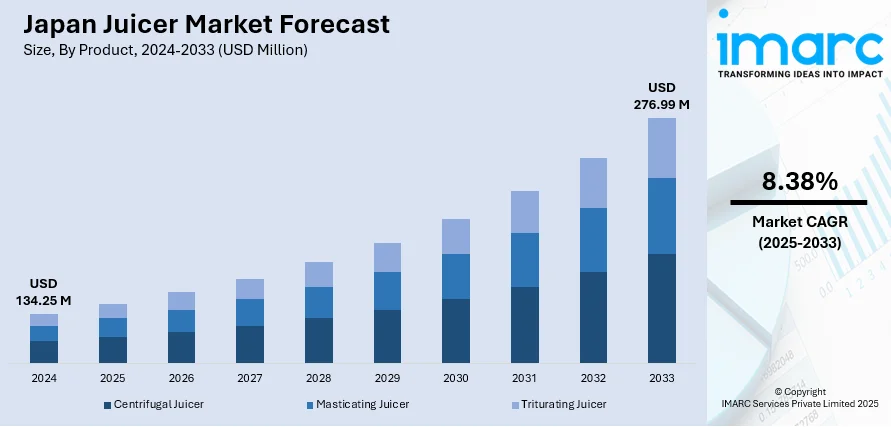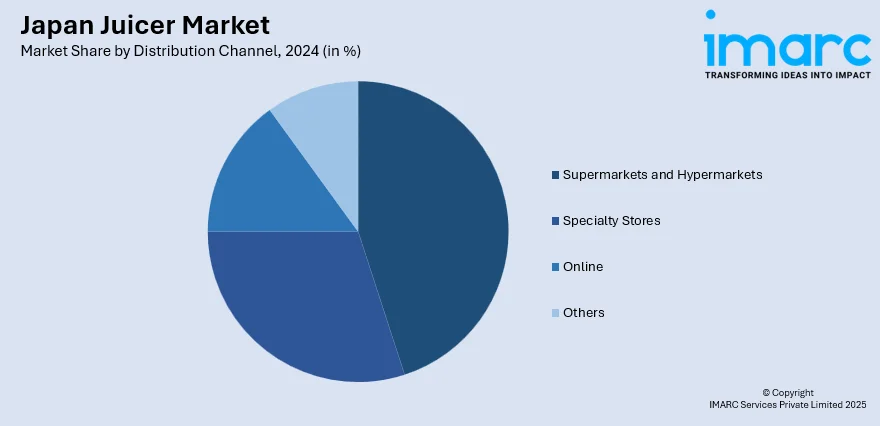
Japan Juicer Market Size, Share, Trends and Forecast by Product, Technology, Distribution Channel, and Region, 2025-2033
Japan Juicer Market Overview:
The Japan juicer market size reached USD 134.25 Million in 2024. Looking forward, IMARC Group expects the market to reach USD 276.99 Million by 2033, exhibiting a growth rate (CAGR) of 8.38% during 2025-2033. The market is spurred on by expanding consumer need for compact, space-efficient appliances that are appropriate for city dwelling. Sustained health awareness is spurring demand for nutrient-preserving cold-press juicers that retain vitamins and enzymes. Moreover, the incorporation of smart technology and customization is attracting technology-oriented consumers looking for convenience and accuracy. These combined factors sustain growth in favor of market enlargement and consumer fulfillment, propelling Japan juicer market share.
|
Report Attribute
|
Key Statistics
|
|---|---|
|
Base Year
|
2024
|
|
Forecast Years
|
2025-2033
|
|
Historical Years
|
2019-2024
|
| Market Size in 2024 | USD 134.25 Million |
| Market Forecast in 2033 | USD 276.99 Million |
| Market Growth Rate 2025-2033 | 8.38% |
Japan Juicer Market Trends:
Growing Focus on Health and Nutritional Consciousness
Japan's juicer market has seen appreciable growth through rising societal focus on health and nutrition. Consumers are highly focusing on the intake of fresh and natural foods, which has increased the demand for appliances that allow preparing nutrient-dense juices at home. This trend is especially evident in the geriatric community, who want to keep their health intact and avoid chronic diseases through nutritional means. Juicers that help maintain the integrity of vitamins, minerals, and enzymes during the process of extraction have become very popular. For instance, in November 2024, Hurom's H400 juicer was chosen by Forbes as the Best Kitchen Product of the Year for its Mega Hopper, silky pulp-free operation, and easy-to-assemble, easy-to-clean, nutrient-preservation design. Moreover, the wider cultural interest in preventive health and wellbeing has also driven the market, with consumers taking up juicing as a habitual trend to complement balanced nutrition. This trend leads to a general sector growth with heightened consumer investment in premium-quality juicing technology. Thus, Japan juicer market growth mirrors convergence of technological progress with changing health-oriented consumer needs, hence driving long-term market growth.

To get more information on this market, Request Sample
Technological Innovation Fueling Market Growth
Technology plays a central role in the transformation and development of the juicer market in Japan. Modern juicers have the advanced features of slow masticating extraction, which reduces the rate of oxidation and preserves nutrients in the resultant juices. Noise reduction technology and energy-saving mechanisms also serve to further boost product appeal through the ability to match consumer needs for quieter and more environmentally friendly domestic appliances. Furthermore, multifunctionality is a key feature now, as most appliances can handle extra food processing tasks such as blending and grinding. These developments cater to consumers who are looking for high-performance, variable kitchen machines that fit in with busy lifestyles. The growth of Japan juicers is partly the result of such technological advancements, which enhance user convenience and juice quality at the same time. Japan juicer market trends clearly reflect this shift, emphasizing how innovation continues to shape consumer preferences and purchasing behavior. Therefore, continued innovation across the industry continues to be imperative in addressing changing consumer needs and sustaining market growth.
Demand for Small and Space-Saving Designs
The direction towards urbanization and smaller residential homes in Japan has had a substantial impact on consumer tastes for small, space-efficient kitchen appliances, such as juicers. Consumers increasingly request juicers that are high in performance but low in physical space requirements that are appropriate for small kitchen counter and storage space. Such a preference is particularly applicable among younger consumer groups and single-person households, which value convenience, easy storage, and maintenance. To this end, manufacturers have concentrated on creating light, ergonomically designed juicers with sleek aesthetics that blend harmoniously in today's kitchen settings. This focus on easy-to-use aspects like easy cleaning and portability further adds to product appeal. The Japan juicer development is an indicator of this sustained trend, pointing to the market's adjustment in line with changing lifestyle needs. This trend points to an overarching move towards functional, low-space-consuming domestic appliances that better suit contemporary spatial and practical limitations.
Japan Juicer Market Segmentation:
IMARC Group provides an analysis of the key trends in each segment of the market, along with forecasts at the country and regional levels for 2025-2033. Our report has categorized the market based on product, technology, and distribution channel.
Product Insights:
- Centrifugal Juicer
- Masticating Juicer
- Triturating Juicer
The report has provided a detailed breakup and analysis of the market based on the product. This includes centrifugal juicer, masticating juicer, and triturating juicer.
Technology Insights:
- Electric
- Manual
A detailed breakup and analysis of the market based on the technology have also been provided in the report. This includes electric and manual.
Distribution Channel Insights:

- Supermarkets and Hypermarkets
- Specialty Stores
- Online
- Others
The report has provided a detailed breakup and analysis of the market based on the distribution channel. This includes supermarkets and hypermarkets, specialty stores, online, and others.
Regional Insights:
- Kanto Region
- Kansai/Kinki Region
- Central/ Chubu Region
- Kyushu-Okinawa Region
- Tohoku Region
- Chugoku Region
- Hokkaido Region
- Shikoku Region
The report has also provided a comprehensive analysis of all the major regional markets, which include Kanto Region, Kansai/Kinki Region, Central/Chubu Region, Kyushu-Okinawa Region, Tohoku Region, Chugoku Region, Hokkaido Region, and Shikoku Region.
Competitive Landscape:
The market research report has also provided a comprehensive analysis of the competitive landscape. Competitive analysis such as market structure, key player positioning, top winning strategies, competitive dashboard, and company evaluation quadrant has been covered in the report. Also detailed profiles of all major companies have been provided.
Japan Juicer Market News:
- In April 2024, HUROM introduced the H70 Easy Clean Slow Juicer, evolving its Easy Clean Series. Utilizing Slow Squeeze Technology that spins at 70 RPM, it retains nutrients and provides high juice output with a low content of pulp. Its sleek design accommodates kitchen countertops, and the enhanced easy-clean chamber makes maintenance easy, solidifying HUROM's position as a leader in innovative, nutrient-centric juicing appliances globally.
Japan Juicer Market Report Coverage:
| Report Features | Details |
|---|---|
| Base Year of the Analysis | 2024 |
| Historical Period | 2019-2024 |
| Forecast Period | 2025-2033 |
| Units | Million USD |
| Scope of the Report |
Exploration of Historical Trends and Market Outlook, Industry Catalysts and Challenges, Segment-Wise Historical and Future Market Assessment:
|
| Products Covered | Centrifugal Juicer, Masticating Juicer, Triturating Juicer |
| Technologies Covered | Electric, Manual |
| Distribution Channels Covered | Supermarkets and Hypermarkets, Specialty Stores, Online, Others |
| Regions Covered | Kanto Region, Kansai/Kinki Region, Central/Chubu Region, Kyushu-Okinawa Region, Tohoku Region, Chugoku Region, Hokkaido Region, Shikoku Region |
| Customization Scope | 10% Free Customization |
| Post-Sale Analyst Support | 10-12 Weeks |
| Delivery Format | PDF and Excel through Email (We can also provide the editable version of the report in PPT/Word format on special request) |
Key Questions Answered in This Report:
- How has the Japan juicer market performed so far and how will it perform in the coming years?
- What is the breakup of the Japan juicer market on the basis of product?
- What is the breakup of the Japan juicer market on the basis of technology?
- What is the breakup of the Japan juicer market on the basis of distribution channel?
- What is the breakup of the Japan juicer market on the basis of region?
- What are the various stages in the value chain of the Japan juicer market?
- What are the key driving factors and challenges in the Japan juicer?
- What is the structure of the Japan juicer market and who are the key players?
- What is the degree of competition in the Japan juicer market?
Key Benefits for Stakeholders:
- IMARC’s industry report offers a comprehensive quantitative analysis of various market segments, historical and current market trends, market forecasts, and dynamics of the Japan juicer market from 2019-2033.
- The research report provides the latest information on the market drivers, challenges, and opportunities in the Japan juicer market.
- Porter's five forces analysis assist stakeholders in assessing the impact of new entrants, competitive rivalry, supplier power, buyer power, and the threat of substitution. It helps stakeholders to analyze the level of competition within the Japan juicer industry and its attractiveness.
- Competitive landscape allows stakeholders to understand their competitive environment and provides an insight into the current positions of key players in the market.
Need more help?
- Speak to our experienced analysts for insights on the current market scenarios.
- Include additional segments and countries to customize the report as per your requirement.
- Gain an unparalleled competitive advantage in your domain by understanding how to utilize the report and positively impacting your operations and revenue.
- For further assistance, please connect with our analysts.
 Request Customization
Request Customization
 Speak to an Analyst
Speak to an Analyst
 Request Brochure
Request Brochure
 Inquire Before Buying
Inquire Before Buying




.webp)




.webp)












